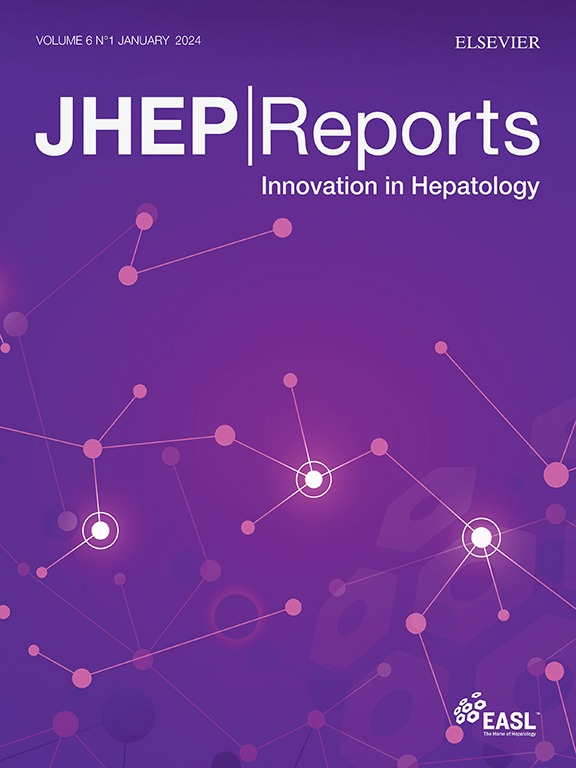Liver transplantation for HBV-related liver disease: Impact of prophylaxis for HBV on HCC recurrence
IF 9.5
1区 医学
Q1 GASTROENTEROLOGY & HEPATOLOGY
引用次数: 0
Abstract
Background & Aims
Conflicting data exist regarding optimal prophylaxis for HBV recurrence (HBV-R) after liver transplantation (LT), particularly in patients with hepatocellular carcinoma (HCC). We assessed current practices for HBV-R prophylaxis in Italy, evaluating rates, risk factors, and the clinical impact of HBV-R and HCC-R.
Methods
We performed a multicentric, retrospective study involving 20 Italian LT centers. All patients who underwent LT for HBV-related liver diseases between 2010 and 2021 were included. Logistic regression was used to identify predictors of HBV-R and HCC-R. Survival curves were estimated with the Kaplan-Meier method and compared with the log-rank test.
Results
We included 1,205 LT recipients (60.8% with HCC). HBV prophylaxis was prescribed in 99.7% of recipients, mostly with lifelong hepatitis B immunoglobulin+nucleos(t)ide analogues (HBIG+NUCs) (83.9%). Rates of HBV-R were 2.1% and 3.1% in patients transplanted without and with HCC, respectively. Median times from LT were 60 [9.5–77.5] and 5.5 [1–13] months, respectively. Recipients on lifelong HBIG+NUCs experienced lower rates of HBV-R than those in whom HBIG was withdrawn, used only during LT, or in those who received NUCs alone (2.3% vs. 6.2% vs. 1.9% vs. 8%, respectively; p = 0.042). In recipients with HCC, HCC-R rate was 10.8% (median time from LT: 18 months). At multivariate analysis, HBV-R (odds ratio [OR] 10.329; 95% CI 3.665-29.110), Child-Pugh C (OR 3.519; 95% CI 1.305-9.484), and microvascular invasion (OR 3.088; 95% CI 1.692-5.634) were independently associated with HCC-R. Five-year survival was lower in recipients who experienced HCC-R (32.5% vs. 92.4% in those who did not; p <0.001).
Conclusion
In Italy, HBV prophylaxis is mostly based on lifelong HBIG+NUCs. HBV-R was rare and not associated with survival in patients transplanted for decompensated cirrhosis. In patients transplanted for HCC, HBV-R was independently associated with HCC-R. The clinical implications of these findings deserve further investigation.
Impact and implications:
In Italy, the combination of high-barrier nucleos(t)ide analogues and hepatitis B immunoglobulins remains the most widely used regimen for antiviral prophylaxis following liver transplantation for HBV-related liver disease. Hepatitis B recurrence after liver transplantation is a rare event and not associated with reduced survival. In transplant recipients with hepatocellular carcinoma, HBV recurrence was independently associated with hepatocellular carcinoma recurrence, though this may simply reflect an epiphenomenon without any causal relationship.

求助全文
约1分钟内获得全文
求助全文
来源期刊

JHEP Reports
GASTROENTEROLOGY & HEPATOLOGY-
CiteScore
12.40
自引率
2.40%
发文量
161
审稿时长
36 days
期刊介绍:
JHEP Reports is an open access journal that is affiliated with the European Association for the Study of the Liver (EASL). It serves as a companion journal to the highly respected Journal of Hepatology.
The primary objective of JHEP Reports is to publish original papers and reviews that contribute to the advancement of knowledge in the field of liver diseases. The journal covers a wide range of topics, including basic, translational, and clinical research. It also focuses on global issues in hepatology, with particular emphasis on areas such as clinical trials, novel diagnostics, precision medicine and therapeutics, cancer research, cellular and molecular studies, artificial intelligence, microbiome research, epidemiology, and cutting-edge technologies.
In summary, JHEP Reports is dedicated to promoting scientific discoveries and innovations in liver diseases through the publication of high-quality research papers and reviews covering various aspects of hepatology.
 求助内容:
求助内容: 应助结果提醒方式:
应助结果提醒方式:


